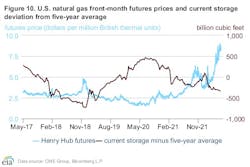EIA: US natural gas inventories end May down 15% year-on-year
US natural gas inventories ended May at 1,983 bcf, 351 bcf (15%) lower than the 5-year average, the Energy Information Administration (EIA) said in its latest Short-Term Energy Outlook. US natural gas stock builds in May were 386 bcf, compared with a 5-year average of 417 bcf.
The below-average storage builds at the beginning of this injection season along with a forecast of average storage injections this summer mean that EIA expects natural gas inventories to begin the winter heating season 9% below their 5-year average.
EIA also forecasts that US LNG exports will average 11.7 bcfd during second- and third-quarter 2022 and 11.9 bcfd for all of 2022, a 22% increase from 2021, a result of additional US LNG export capacity that has come online.
Since the end of 2021, the European Union and the UK have imported record LNG volumes because of low natural gas inventories. Europe has become the main destination for US LNG exports and accounted for 74% of total US LNG exports during the first 4 months of 2022. EIA forecast LNG exports will average 12.6 bcfd in 2023, as export terminals that came online in mid-2022 are operational for the whole year in 2023.
Meanwhile, EIA expects US consumption of natural gas to average 85.3 bcfd in 2022, up 3% from 2021. Rising US natural gas consumption reflects increased consumption across all sectors. In particular, limited natural gas-to-coal switching in the electric power sector, despite high natural gas prices, resulted in increased consumption of natural gas for power generation.
US dry natural gas production will average 95.7 bcf/d in June and 97.9 bcf/d in second-half 2022, 2.7 bcfd (3%) more than second-half 2021, EIA forecasts. EIA expects dry natural gas production to average 101.6 bcfd in 2023.
Futures price spread
The natural gas May 1–13 price spread averaged $3.37/MMbtu, the highest average monthly backwardation (where near-term contract prices are higher than longer-dated contract prices) on record, according to CME Group data.
Natural gas futures prices have been increasingly backwardated since early March. The 1st –13th price spread averaged $1.28/MMbtu in March and $2.36/MMbtu in April. Often, the 1st –13th price spread increases when natural gas inventories are below the 5-year range, and the price spread often decreases when inventories are above the 5-year range.
Low storage inventories to start the injection season, lower-than-expected production levels compared with late 2021, continued high demand for US LNG, and high demand from the electric power sector are all contributing to near-term natural gas prices being much higher now compared with natural gas futures prices for delivery next year, EIA said.



